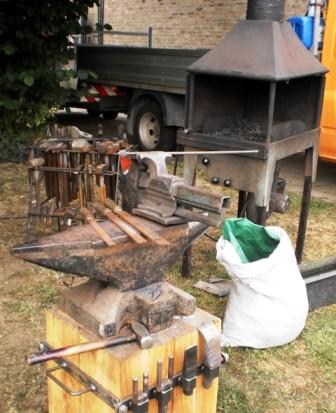Wrought iron is iron that was made by forging (no smelting).
The further processing can be done with a forge: the two mud walls separated by the charcoal.
On one side there is a hole through which by two coupled bellows air is blown. The temperature is much higher here than that of the iron furnace.
 After often heating and forging you get a square bar. On the surface, the slag is forged out and the iron good wrought trough, but not yet in the inner core. To get the slag out the bar it is at least 10 times forged into a thin, flat bar, folded and strongly welded together again.
After often heating and forging you get a square bar. On the surface, the slag is forged out and the iron good wrought trough, but not yet in the inner core. To get the slag out the bar it is at least 10 times forged into a thin, flat bar, folded and strongly welded together again.
Of 30 kg bloom ultimately remains about 10 kg of iron bars. Much contact with charcoal allows to absorb it, making it stronger iron (carbonization).
It has a better tensile strength than cast iron, but with a lower compressive strength. It seems a bit more like steel. Hammering expels slag and burns excess carbon to the air.
The process is so time-consuming and labor-intensive because the required high temperature cannot be achieved in order to really iron melting (1,535°C).
Natural coal with trace elements such as sulfur can spoil the iron.
Charcoal is better, purer. Coal must burn free from air to cokes so disturbing elements can escape.
